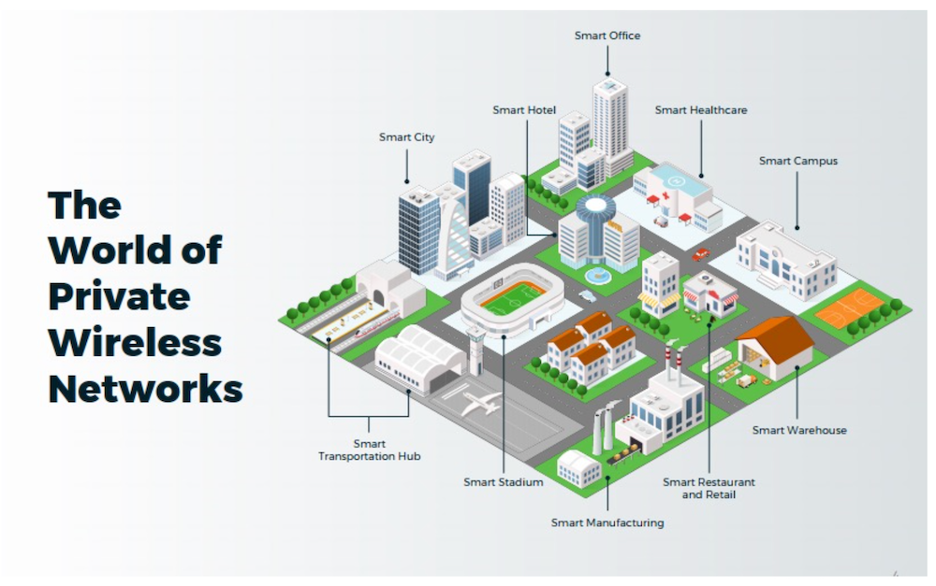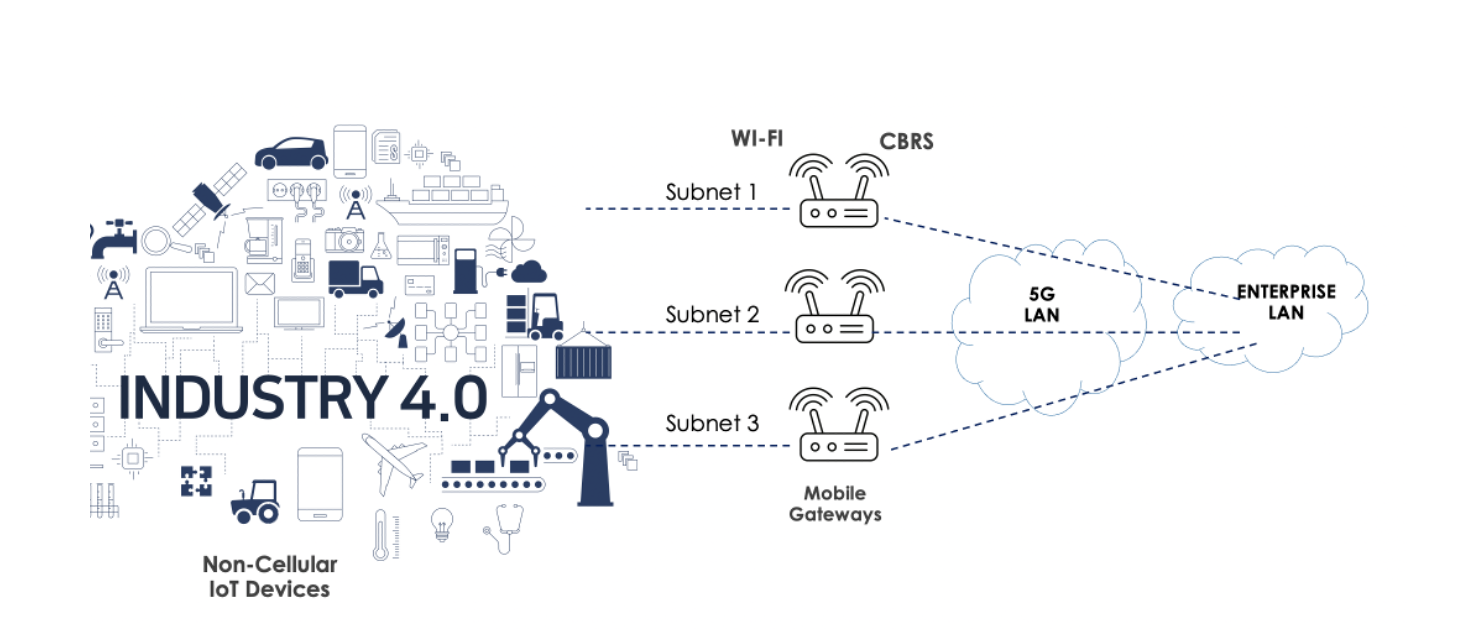First off, let’s talk about vocabulary. We all know words have meaning – sure, but we have also been confused many times in the past when people ‘re-use’ words for their own meaning. Nothing at all wrong with this, but it can lead to some confusion.
So, to start off, in Intel’s presentation, they are using the term “Private Networks” as a way to describe the use of cellular technology, but when this LTE network is owned and operated by a private entity. This is in comparison with a “Public Network” when a cellular operator owns and operates an LTE infrastructure and sells either minutes or kilobytes of data.
For over a generation now, these Public Networks have been driven by a term ARPU – or Average Revenue Per User. That is the metric for success or failure of Public Networks. Cellular carriers work very hard to keep ARPU at the front of mind.
Private Networks vs Public Networks
In direct comparison, a Private Network is not driven by ARPU, but by the lack of ARPU in any equation. Private Networks may use the same LTE technology, and some of the same infrastructure, but the major difference is based on the Radio Frequencies they use.
There are also some very positive comparisons to be made between another type of network you may be used to. That would be a Wireless LAN. WLANs are also a type of private network, where the infrastructure is owned and operated by a private company for their own internal uses. We’ve been designing, installing, and troubleshooting Wi-Fi networks for two decades now.
The benefits of Wi-Fi, when compared with cellular in the past, have been the tradeoff between the FREE access to unlicensed spectrum – in the case of Wi-Fi that has been 2.4GHz and 5GHz – compared with the extremely expensive frequencies the cellular carriers had to pay at auction when bidding against other cellular carriers. Thus, the huge difference between a cellular carrier being worried about ARPU, and Wi-Fi being perceived as a much cheaper alternative.
In comes a set of new frequencies in the 3.55GHz to 3.7GHz range called Citizens Broadband Radio Service (not to be confused with the old CB radios from the past that was called Citizens Band…). These frequencies have been opened to a way that allows ‘sharing’.
If you are interested in learning more about the techniques, do some research on CBRS to learn how various countries allocate. You can also find various databases that allow for local use of these CBRS frequencies for normal companies to use.
Private Networks vs Wireless LAN (Wi-Fi)
Some of the major drawbacks to Wi-Fi are its limited range, and the unlicensed spectrum it uses. Anyone has a right to use these frequencies, and the ‘listen before talk’ algorithms built into Wi-Fi enforce that only one device can transmit on these unlicensed frequencies at a time, leading to many throughput issues in Wi-Fi caused because of contention.
Along comes the technology of LTE with its benefits of long range, more coverage, and better capacity – now coupled with these new CBRS frequencies where a company can have control of frequencies they deploy without paying any ARPU to a cellular carrier.
So compared with Wi-Fi solutions, a CBRS Private Network solution needs far fewer ‘Access Points’, while still using the same LAN connections to Layer 2 & Layer 3 infrastructure already in place within enterprises today.
Possible Issues
One of the largest issues confronting Private Networks today are the client devices. For decades now client manufactures have fallen into two camps. Cellular frequencies have been supported in smartphones and some tablets. Wi-Fi frequencies have been supported in laptops, tablets, and smartphones, as well as many smaller IoT devices, or things like handheld scanners and some security video cameras.
In order for a Private Network to work, client devices need to support these CBRS/LTE frequencies. In addition, they need available SIM capacity. Today many clients that may be primed and ready for a Private Network do not yet support these two features. But the good news is, new clients with LTE support are coming to the market each week.
(As an example, my personal iPhone has the ability to support an e-SIM for my cellular carrier connection, leaving the physical SIM slot available for accessing a CBRS network – and many CBRS companies will soon be supporting e-SIMs as well as the current physical SIM support.)
Use Cases
There are MANY use cases for Private Networks. As Wireless LAN engineers, we have come across many situations where standard Wi-Fi isn’t the best solution. Either caused by lack of coverage, control, or capacity.

Here are some situations where a Private Network can be used quickly to solve these tricky situations.
Large Public Venues
In many LPV’s, the customers need Internet access – and that can be accomplished with Wi-Fi. But within that same infrastructure, the company needs guaranteed fast, secure, and controlled access to their own devices and many times this fails because of sharing Wi-Fi between tens of thousands of people and perhaps only a hundred staff.
Leave the Wi-Fi for the customers, and then use a CBRS Private Network for the internal communications needed by employees.
Agriculture
Wi-Fi is great for many things but covering square miles of land for agricultural sensors isn’t one of them. Yet a CBRS solution with its increased coverage, and without ARPU costs of normal cellular, a Private Network makes great sense.
Hospitality
Like LPV, the hospitality industry has an expectation to provide guest Wi-Fi for Internet access. They too have a need for internal staff to have dedicated, consistent, and controlled access to internal network applications and functions. A Private Network is a great solution here. With the increased coverage LTE provides, but without incurring additional ARPU to have staff use their smartphones for connecting to company network resources.
Mining
This is one where I’ve spent a lot of time and effort trying to shoe-horn a Wi-Fi solution into a situation where cellular technology makes much more sense. But getting a cellular carrier to build out cell towers in remote mining locations is a mere pipe dream. Yet a Private Network using dedicated frequencies over company-owned equipment is a solution that fixes these problems. The additional coverage by LTE is an added bonus!
Transportation
Railways, ports, and intermodal yards are much like the mining situation. They NEED consistent connections for data transfers, and have, in the past relied on Wi-Fi based solutions that don’t quite meet all their requirements. And like mining, it is difficult, if not impossible to rely on a cellular carrier to build out cell infrastructure for a single customer.
Here too, a Private Network with its additional capacity, control and especially coverage makes great sense.
Education
Sure, most K-12 schools rely on Chromebooks, iPads and the like for their student learning. But in many districts, the school systems need to support even broader areas than merely inside the classroom. Many schools in less affluent areas may be one of the only sources of low-cost Internet access for doing homework. With dedicated frequencies of CBRS, and perhaps using CBRS to Ethernet dongles, even Chromebooks can access the Internet via school-sponsored Private Networks that cover multiple acres, vs Wi-Fi whose coverage is measured in square feet.
Other Technologies
Sometimes, as Wireless LAN engineers, we are overly focused on using what we know, Wi-Fi/802.11, to solve our customer’s issues. It may feel at times like we have this hammer, and all problems look like a nail.
But what we should be doing is evaluating, testing, and implementing other wireless solutions that may be a better fit for certain situations.
It may be LoRaWAN, Bluetooth, BLE, Zigbee, 6LoWPAN, Sigfox, Z-Wave, 802.15.4, or any of many IoT wireless solutions… but you can also look to CBRS as a solution to give you better Private Networks for your customers.
For further information, check out the CBRS Alliance at www.cbrsalliance.org. To learn more about how Intel supports private networks, watch the video above.




